Six Transcribed Improvisations on La Spagna
Whenever I can, I record my live concerts, even if the available recording equipment is poor. In such cases, the resulting recording would usually be considered useless for many people—especially when you perform the same pieces in roughly the same way in different concerts—since it does not help to present a polished sonic image of one’s self as a professional musician. In my case, however, there is a compelling reason to document every performance: improvisation.
“Once you have been bitten by the improvisation bug, it is not a choice anymore.”1
As I have devoted myself to developing the necessary skills to become a fluent improviser since at least 2005, I have accumulated many live concert recordings with varying degrees of audio quality, but they always contain fresh, improvised musical material. And that is what makes them interesting for me, regardless of their audio quality. That said, I recommend using headphones when listening to the videos in this article.2
La sventurata musica—sì veloce nel morire. [Unfortunate music—so fast to die.]
— Leonardo da Vinci
A lot of the best stuff is gone in the air.
— Eric Dolphy
Among other things, these recordings have allowed me to capture my spontaneous improvisations, document my development, and ultimately provide visual evidence that real improvisation is happening in my performances.
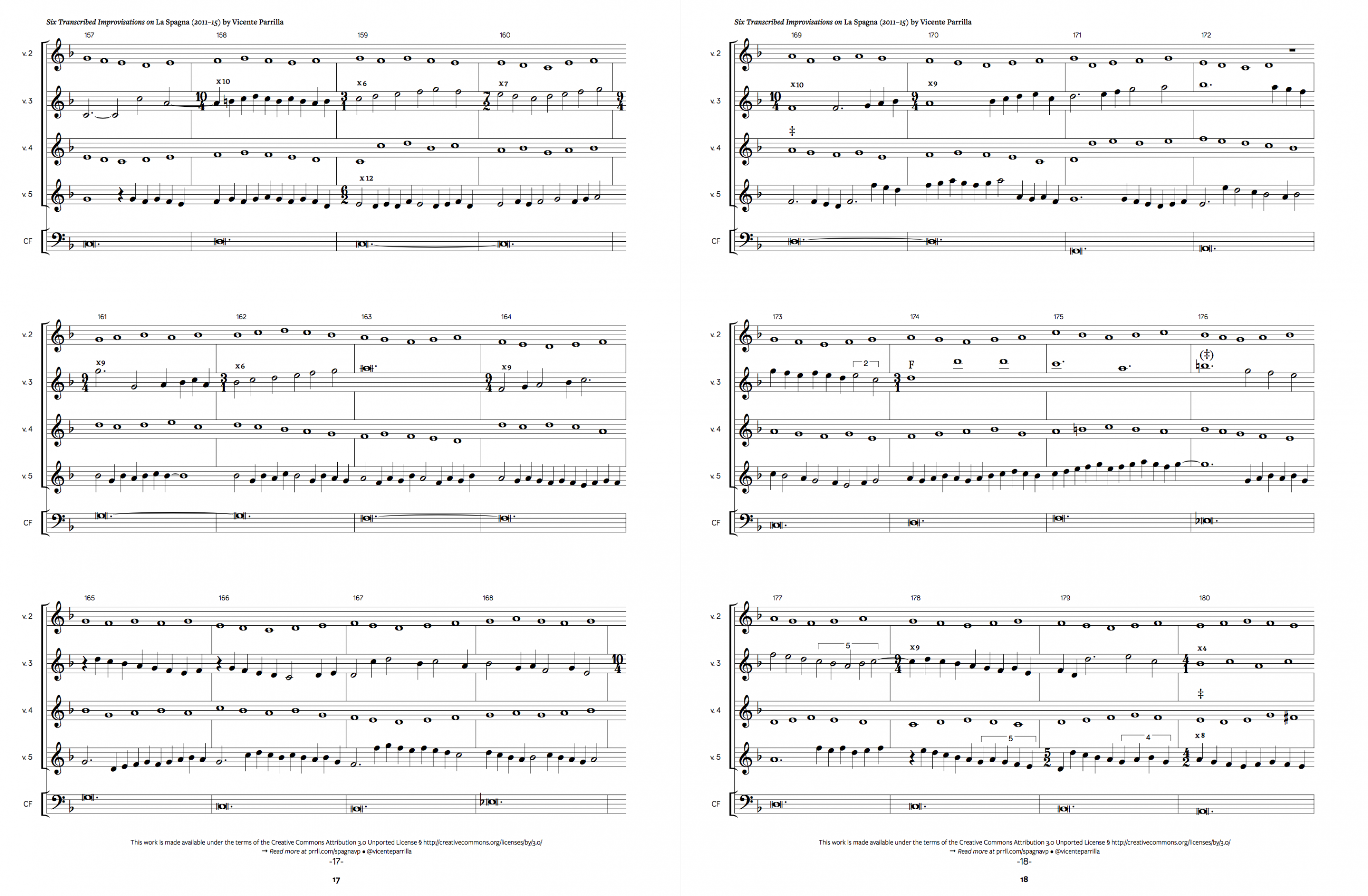
Moreover, the visualization of musical ideas often seems to be a requirement for the academic world to take certain musical matters seriously: Adam Neely calls it “the cult of the written score.”3 I owe the idea of transcribing myself to the alto saxophonist extraordinaire Lee Konitz:
I have suggested that to learn a solo from a record you should listen; sing it; play it; write it down and analyze it. The same should be done for your own solos, so you can confront what you play, study it, and enjoy the process.
— Lee Konitz, Conversations on the Improviser’s Art, 117
Since I began transcribing my recordings, it has taken me more than two years to collect the material I am publishing here today. Yes, that is a long time, but look at the numbers:
- I needed a few months to transcribe the 34 minutes of audio.
- Add to that a few months to prepare the music score e-edition PDF (99 pages, including preface, score, and parts).
- And some further months went into the making of the six new videos with audio-synchronized, animated transcription that I am releasing today.
So I am very happy to finally share the transcription of the six available recorded versions I have so far of La Spagna, dating from 2011–15. Below you can find the complete transcriptions (score and parts) as a free PDF download. Do not miss the series of synchronized transcription videos.
Talk is cheap. Show me the code.
— Linus Torvalds, message to linux-kernel mailing list, August 25, 2000
Free Download
☆ “Six transcribed improvisations on La Spagna, 2011–15”, score and parts (99 pp., 1 MB PDF)

A Note About the Musical Notation
In transcribing these improvisations, I aimed to keep the notation as simple as possible. Therefore, I have generally avoided tuplets for notating irregular rhythms, instead using rhythmic proportions in their simplest possible expression: ×5, ×18, etc., meaning, respectively, five notes in the time of one in the cantus firmus or, even more explicitly, eighteen notes in the counterpoint line for every note of the cantus firmus. In addition, I decided to keep the original cantus firmus note values, which translate as long note values in my counterpoint lines by today’s standards, but that choice made things easier for me and is, I believe, easy to get used to.
Symbols:
- Numbers (2–10) set in a big font in the middle of a score indicate a new repetition of the cantus firmus (see bar 47, for instance).
- ‡: A double dagger indicates a wrong note according to Renaissance counterpoint rules, referring mostly to perfect intervals being approached by similar or parallel motion (I did not take the time to be exhaustive).
- (‡): The same sign in parentheses usually indicates wrong, but I really meant it.
- F: free counterpoint, mixed proportions, imitation.
- ×3–×18: rhythmic proportions (see above).
On the Cantus Firmus
La Spagna
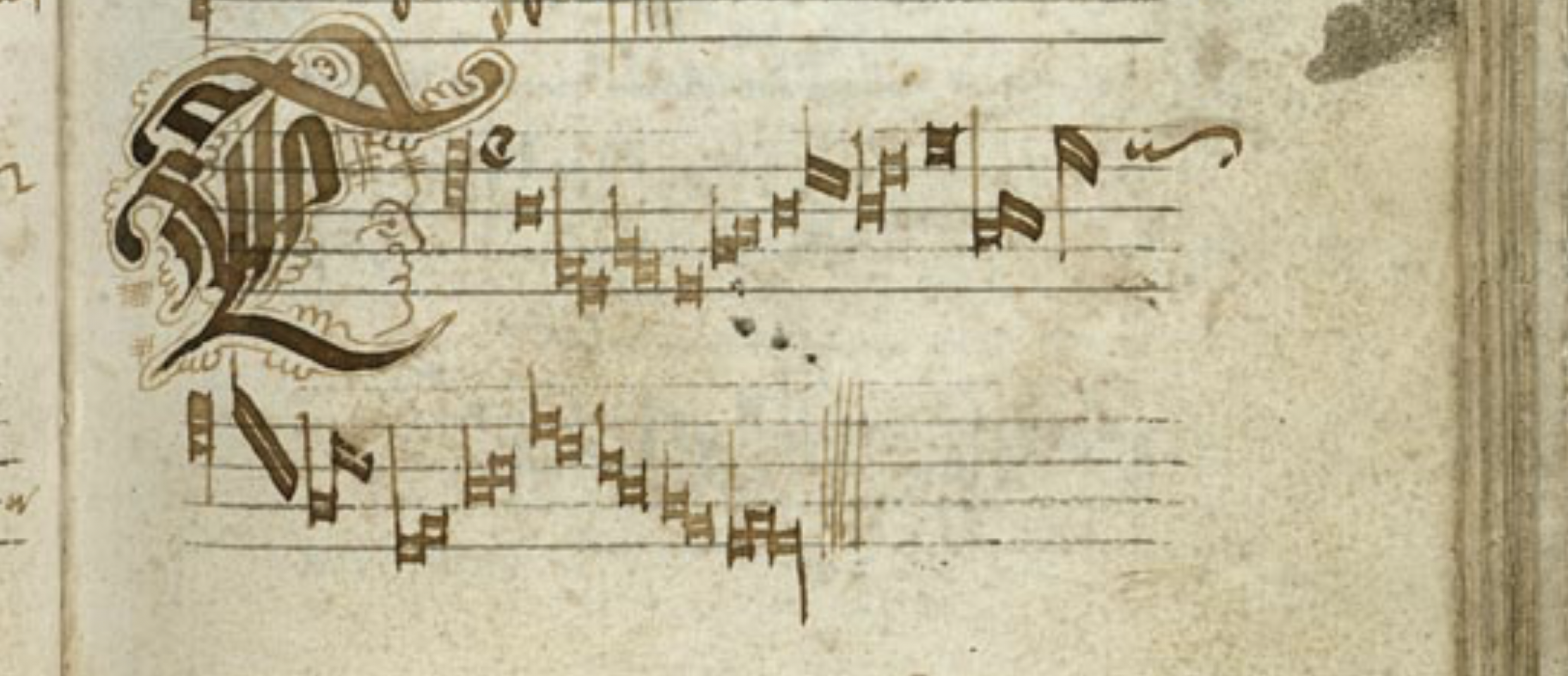
When a melody is used in a relatively slow, even rhythm, with other lines added to it, we call it a cantus firmus.
— Peter Schubert, Modal Counterpoint Renaissance Style, 18
One of the most recent pieces I have added to my improvisation repertory is the cantus firmus La Spagna. This has been a bit of a challenge for me because, except for a few Renaissance polyphonic madrigals, I have mainly worked so far with relatively short repeated (ostinato) bass patterns.
This cantus firmus was a basse danse tenor, a musical line on which to improvise or compose polyphonic elaborations … The internationally known melody existed incognito as—among other designations—“La Spagna,” “Spanier tantz,” “Tenore del re di Spagna,” “Castille la novele,” … “La basse dance de Spayn” and “La bassa castiglya.”
— Richard J. Agee, “Costanzo Festa’s ‘Gradus ad Parnassum,’” Early Music History 15, 1996, 3.
Although, naturally, I was familiar with the cantus firmus La Spagna, having known and played many of the extant fifteenth-century duo settings of it for many years, it was not until 2011, on the occasion of a CD recording project collaboration, that I started playing the cantus firmus itself on one of the pieces of the programme, and conceived the idea of improvising upon it. Now, let me explain a bit of what I have done with it so far.
About the Performances
A Brief Commentary on the Performances (with Synchronized Transcription Videos)

Because it would be very incongruous for that which can be performed not to be able to be written down.
— Tractatus figurarum, ed. Philip Schreur, 70.
1. Version 1 of 6 (2011)
The recorded arrangement started with the cantus firmus melody itself and was intended to show its plausible medieval origin prior to a fifteenth-century polyphonic setting by Isaac. For this reason, it was first performed in parallel fifths, thus evoking early organum and conductus styles. In that section of the piece, I was just playing the melody a fifth higher than the viols, although in one of the takes I started filling in the transposed cantus firmus with improvised motifs. I succeeded in keeping the fifths during my improvisation except for a few bars (29–36 in the transcription) in which I switched to octaves. Both takes (plain fifths and the improvised one) were included, so the recorder appears overdubbed on this track.

Video 1: synchronized transcription
Six improvisations on La Spagna [1/6]

Table 1. Version 1: key data
| Source | Recording date | MM (dotted brevis) | Number of cantus firmus repetitions | Number of bars | Duration of the improvised solo | Proportions | Audio link | Video link |
|---|---|---|---|---|---|---|---|---|
| CD recording: Las idas y las vueltas | November 20, 2011 | ±44 | 1 | 45 | 1′ 03″ | Free, ×6 & ×12 | Spotify | YouTube |
(See Table 7 below for a comparison of the key data of the six versions).
Musicians
Accademia del Piacere
Fahmi Alqhai, viola da gamba and musical direction; Rami Alqhai and Johanna Rose, viola da gamba; Juan Ramón Lara, violone; Vicente Parrilla, recorders; Enrike Solinís, Baroque guitar; Agustín Diassera and Pedro Estevan, percussion.
2. Version 2 of 6 (2013)
After some touring following the 2011 CD release, this 2013 date, featuring the debut of a new quartet, was the first time I included La Spagna in one of my own concert programmes. It was a big step since I went from improvising on a fixed section of one minute (one repetition of the cantus firmus, see the above video) to a fully improvised, open-ended performance, which that particular day happened to last about five minutes (six repetitions of the cantus firmus). This can be liberating for exploration and improvisation, yet far more demanding.
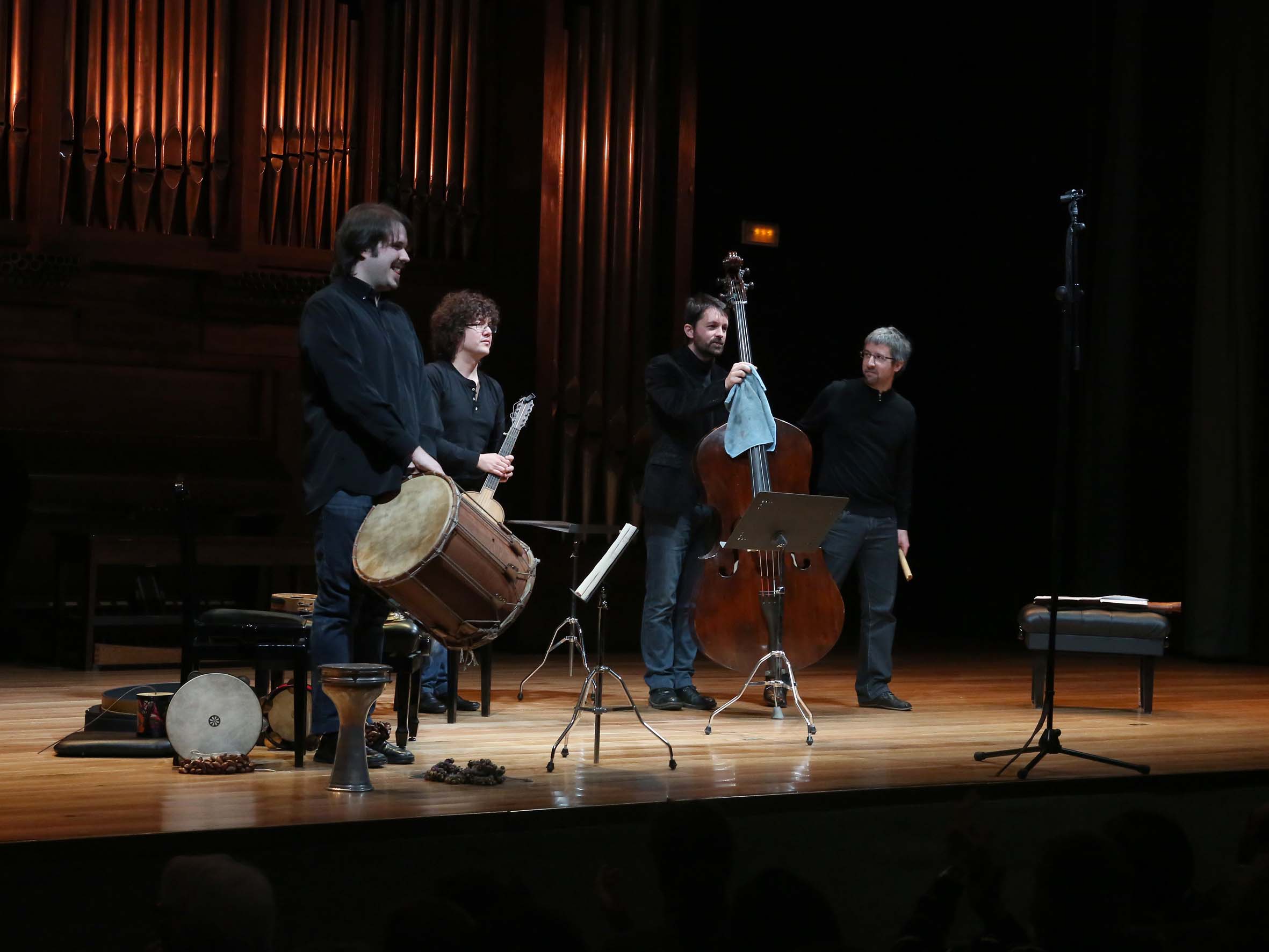
At that time I still kept the initial fifths approach from the first medieval version (arriving at the interval of a perfect fifth in my counterpoint at the beginning of every note of the cantus firmus) most of the time, occasionally adding some thirds and octaves. As a result, most fifths are necessarily approached by similar or parallel motion. A total disaster according to counterpoint rules, but at that time the sonority of the fifths really helped me find my way through the long tenor melody (useful while you are still in a learning process). After all, it was the first time I performed a long, fully improvised version of the piece in front of an audience. The good news is that I was able to get rid of this method in later versions.
It was also the first time I started experimenting with rhythmic proportions in a structured way, trying to achieve a progressive accelerando (×1 to ×5) and a final rallentando (×4, ×3, ×2.5, ×2 and ×1). I was joined by Pablo, who soon started adding proportions in the bass line, and then the real fun began: polyrhythms!
Video 2: synchronized transcription
Six improvisations on La Spagna [2/6]

Table 2. Version 2: proportions and polyrhythms
| Cantus firmus repetition | Bar number | Time (video) | Proportions (recorder) | Proportions (bass) |
|---|---|---|---|---|
| [Cantus firmus intro, not transcribed] | x | 0′ 07″ | ×1 | ×1 |
| 1 | 1 | 1′ 06″ | ×2 | ×1 |
| 2 | 47 | 2′ 07″ | ×2 | ×1 |
| 3 | 93 | 3′ 01″ | ×3 | ×2 |
| 4 | 139 | 3′ 53″ | ×5 | ×3 |
| 5 | 185 | 4′ 44″ | ×5, ×5, ×7 | ×4 |
| 6 | 231 | 5′ 30″ | ×3 | ×4 |
| 6 | 241 | 5′ 43″ | ×4 | ×3 |
| 6 | 254 | 5′ 56″ | ×3 | ×2 |
| 6 | 258 | 6′ 00″ | ×3, ×2.5, ×2, ×1 | ×1 |
Musicians
Vicente Parrilla “Basque Quartet”
Vicente Parrilla, recorder; Enrike Solinís, guitar; Pablo Martín Caminero, bass; Daniel Garay, percussion.
3. Version 3 of 6 (2014)
A fifteenth-century-based piece performed on recorder plus audio tape? Well, considering it was a solo concert, I had few options. This performance, at Coimbra’s conservatory, took place a few days before another concert with the same solo programme in Porto (version 4 below). Thanks to Inês Moz Caldas and Fernando Paz (who also made the audio recording used here) for their invitation to perform.
Two advantages of using pre-recorded audio for the cantus firmus: since the tape was playing it in a loop, it was always rhythmically consistent (which is really helpful when playing complex rhythmic proportions on top), and I did not have to worry about someone getting tired after playing it over and over—a real cantus firmus machine.4 So I took my time and delved into it for more than eight minutes.
Video 3: synchronized transcription
Six improvisations on La Spagna [3/6]

A year after the previous version, I was finally freed from the need to use fifths as an aural guide through the cantus firmus (although still not entirely successful in strictly following the Renaissance counterpoint rules by ear), broadening my interval palette with thirds, sixths, and octaves as the main intervals on top of each cantus firmus note. Although I kept the rhythmic accelerando and rallentando achieved by proportions as a general principle, I was not so strict as in version 2, opting for more free sections and freely jumping among different proportions whenever I felt like. As I transcribed the recorded audio, I was amused by a few things I did not recall doing after the performance.5
Table 3. Version 3: proportions
| Cantus firmus repetition | Bar numbers | Time (video) | Proportions |
|---|---|---|---|
| 1 | 8–27 | 0′ 12″ | Free: ×0.5, ×1, ×3, ×2, ×1.5, ×3 |
| 1 | 28–35 | 0′ 42″ | ×2 |
| 1 | 36–46 | 0′ 54″ | ×3, ×2, ×3 |
| 2 | 47–68 | 1′ 10″ | ×4 |
| 2 | 68–83 | 1′ 44″ | ×5 |
| 2 | 84–87 | 2′ 06″ | ×6, ×5 |
| 2 to 3 | 88–118 | 2′ 12″ | ×7 (except bars 93, 96 & 105, ×6) |
| 3 | 119–132 | 2′ 59″ | ×8 |
| 3 to 4 | 133–157 | 3′ 20″ | ×9 (except bar 146, ×12) |
| 4 | 158–182 | 3′ 57″ | Free: ×10, ×6, ×7, ×9, ×6, ×9, ×10, ×9, etc. |
| 4 to 5 | 183–210 | 4′ 34″ | ×9 |
| 5 to 6 | 211–236 | 5′ 17″ | ×12 (except bar 234, ×9) |
| 6 | 237–252 | 5′ 55″ | ×9 (except bars 243–245 & 249, ×6) |
| 6 | 253–257 | 6′ 20″ | Free: ×6, ×9, ×3, ×4, ×6 |
| 6 | 258–264 | 6′ 27″ | ×4 |
| 6 | 265–270 | 6′ 37″ | ×3 |
| 6 to 7 | 271–292 | 6′ 47″ | ×2 |
| 7 | 293–298 | 7′ 20″ | ×3 (except bar 296, ×6) |
| 7 | 299–308 | 7′ 28″ | ×2 |
| 7 | 309–321 (end) | 7′ 44″ | ×1 (with increasing rests = progressively displaced note) |
Musician
Vicente Parrilla, recorder and tape.
4. Version 4 of 6 (2014)
This performance, from May 3, 2014, took place just three days after the previous one. This is the fourth piece of the programme I conceived for my concert at the III Erta Iberia annual meeting, held in Porto. Again, it was a solo performance (and hence the tape again), this time in front of an audience that comprised a good handful of fellow recorder players, makers, colleagues, and educators.

This is the longest of the six versions: an 11′ 26″ improvisation (ten repetitions of the cantus firmus) in which I decided to explore one rhythmic proportion for each repetition of the tenor melody in a more rigorous way than I had previously done (see Table 4 below).6
If I had to highlight one thing from this version, it would probably be imitation: it was almost certainly the first time that I happened to repeat a few extemporaneously conceived melodic motifs (at different pitch levels) a few times in a row on top of the cantus firmus.7 Moreover, the transcription allowed me to discover that a few other motifs appeared again in different parts of the improvisation.8
Video 4: synchronized transcription
Six improvisations on La Spagna [4/6]
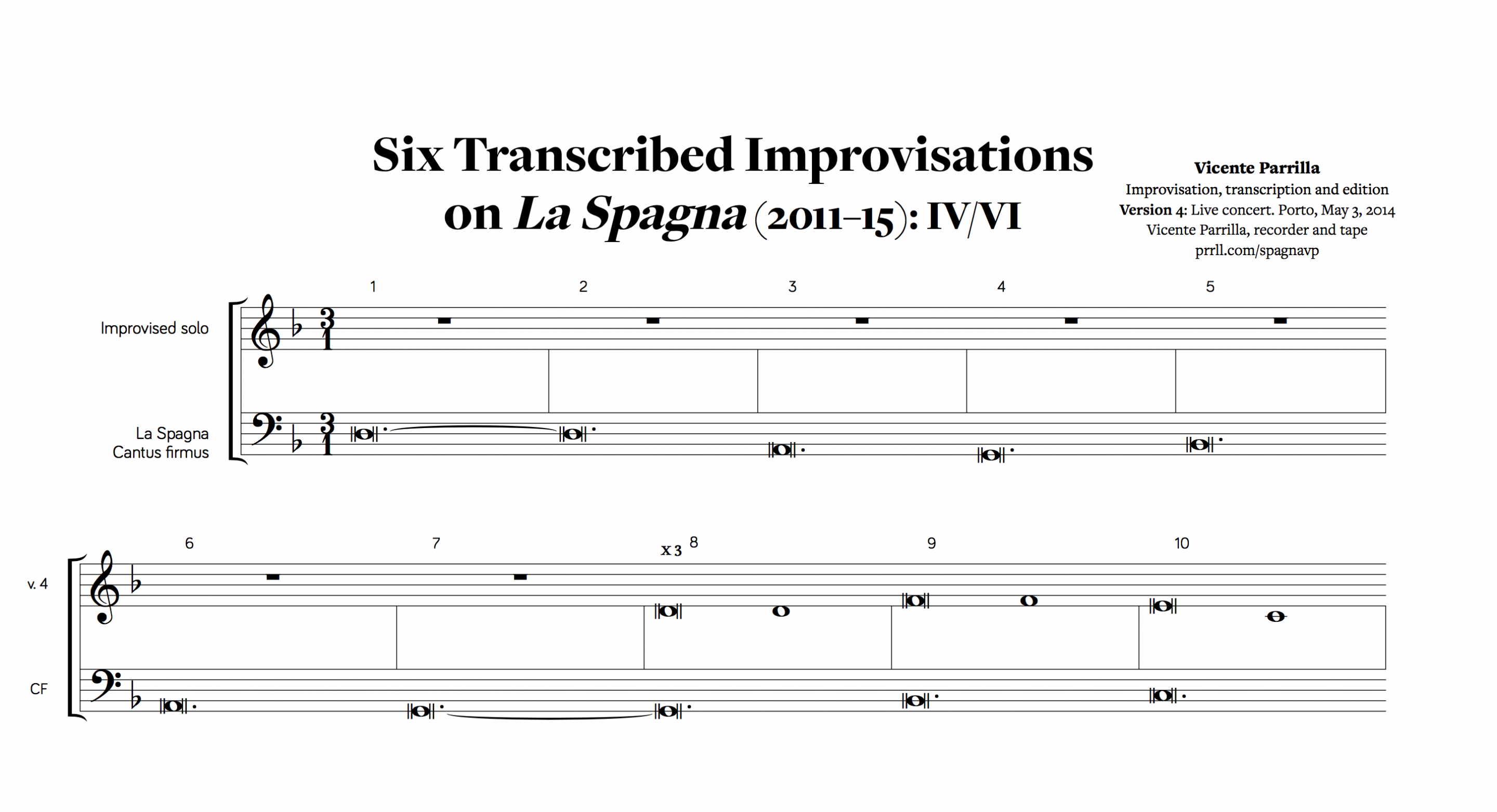
Table 4. Version 4: proportions
| Cantus firmus repetition | Bar numbers | Time (video) | Proportions |
|---|---|---|---|
| 1 | 11–46 | 0′ 16″ | ×2 |
| 2 | 47–92 | 1′ 10″ | ×3 |
| 3 | 93–138 | 2′ 19″ | ×4 |
| 4 | 139–184 | 3′ 28″ | ×5 |
| 5 | 185–230 | 4′ 37″ | ×6 |
| 6 | 231–276 | 5′ 46″ | ×7 |
| 7 & 8 | 277–368 | 6′ 55″ | ×8 to ×12; free (mostly ×10 & ×12); ×16; imitation |
| 9 | 369–414 | 9′ 13″ | ×6, ×4, ×3, ×2; free; imitation |
| 10 | 415–459 (end) | 10′ 21″ | Free; imitation; ×1 |
Musician
Vicente Parrilla, recorder and tape.
5. Version 5 of 6 (2014)
Again, this performance, from May 16, 2014, at the Warsaw Music Encounters Festival, followed closely after the previous one (version 4); it took place only two weeks later. Having not included it in the programme, we performed this improvisation on La Spagna as an encore. That is why we kept it relatively short.

Since I took some time before starting to play,9 I decided to speed up my usual process of gradually augmenting the value of the rhythmic proportions, going from ×1 to ×12 in only four repetitions of the cantus firmus (159 bars). As it was a performance with an open structure (we had not defined any shape other than the gradual increase and decrease of rhythmic proportions), a lengthy, strict rallentando in proportion (from ×6 to ×1) definitely helped in defining a clear ending for the piece.
A fair number of new melodic, recurring imitative motifs started emerging as soon as I abandoned the (self-imposed) idea of progressive proportional accelerando in favour of free counterpoint, somehow managing to keep these motifs coming for about forty bars in a row (bars 139–179).
Video 5: synchronized transcription
Six improvisations on La Spagna [5/6]
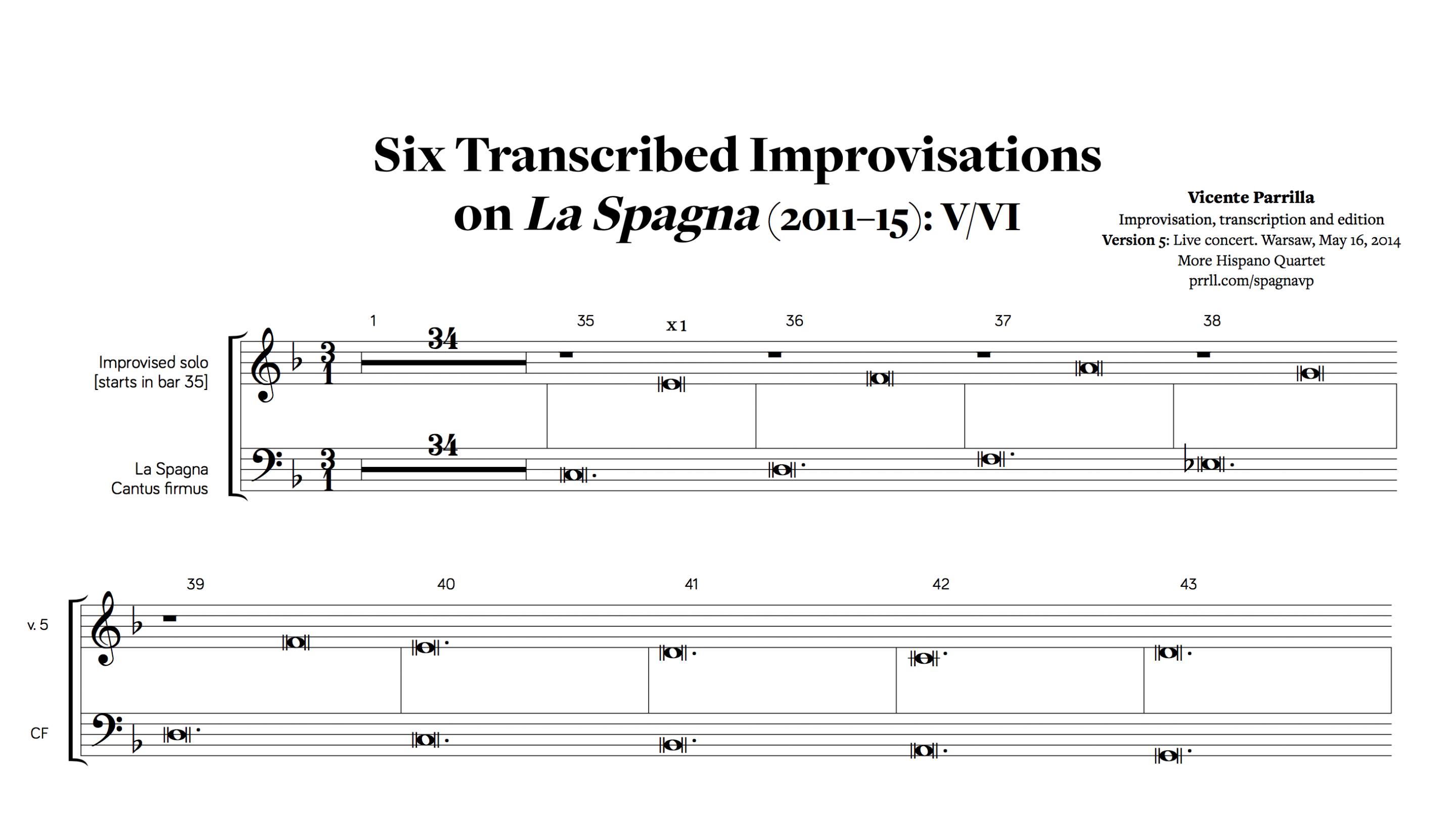
Table 5. Version 5: proportions
| Cantus firmus repetition | Bar numbers | Time (video) | Proportions |
|---|---|---|---|
| 1 | 35–46 | 0′ 59″ | ×1 (bars 35–46) |
| 2 | 47–81 | 1′ 20″ | ×2 (bars 47–65), ×3 (66–72), ×4 (73–81) |
| 2 to 3 | 82–99 | 2′ 15″ | ×5 |
| 3 | 100–136 | 2′ 44″ | ×6 (100–114), ×7 (115–124), ×8 (125–136) |
| 3 to 4 | 137–158 | 3′ 43″ | ×10; imitative motifs |
| 4 | 159–184 | 4′ 19″ | Free; imitative motifs; ×12 (159–178), ×10 (178–179), ×8 (179–184) |
| 5 | 185–229 (end) | 5′ 01″ | ×6 (185–190), ×5 (191–194), ×4 (195–198), ×3 (199–204), ×2 (205–213), ×1 (214–229) |
Musicians
More Hispano Quartet
Vicente Parrilla, recorder; Juan Carlos Rivera, vihuela; Rami Alqhai, viola da gamba; Javier Núñez, harpsichord.
6. Version 6 of 6 (2015)
On March 15, 2015, I had the chance to share the stage with the great Italian jazz pianist Enrico Pieranunzi at the Sevilla Early Music Festival (FeMÀS). It was the first time, and so far the only one (yes, I probably need a manager), that we performed together. A truly wonderful experience.
“Fine, it was an audiotape first… and now a fifteenth-century-based piece performed on recorder and piano?” Well, I think we managed to prove once more that, thanks to improvisation, it is possible for two musicians with completely different backgrounds to quickly establish a musical dialogue (we only had a single evening’s rehearsal the day before the concert, the first day we ever met), and easily communicate with each other and with the audience.
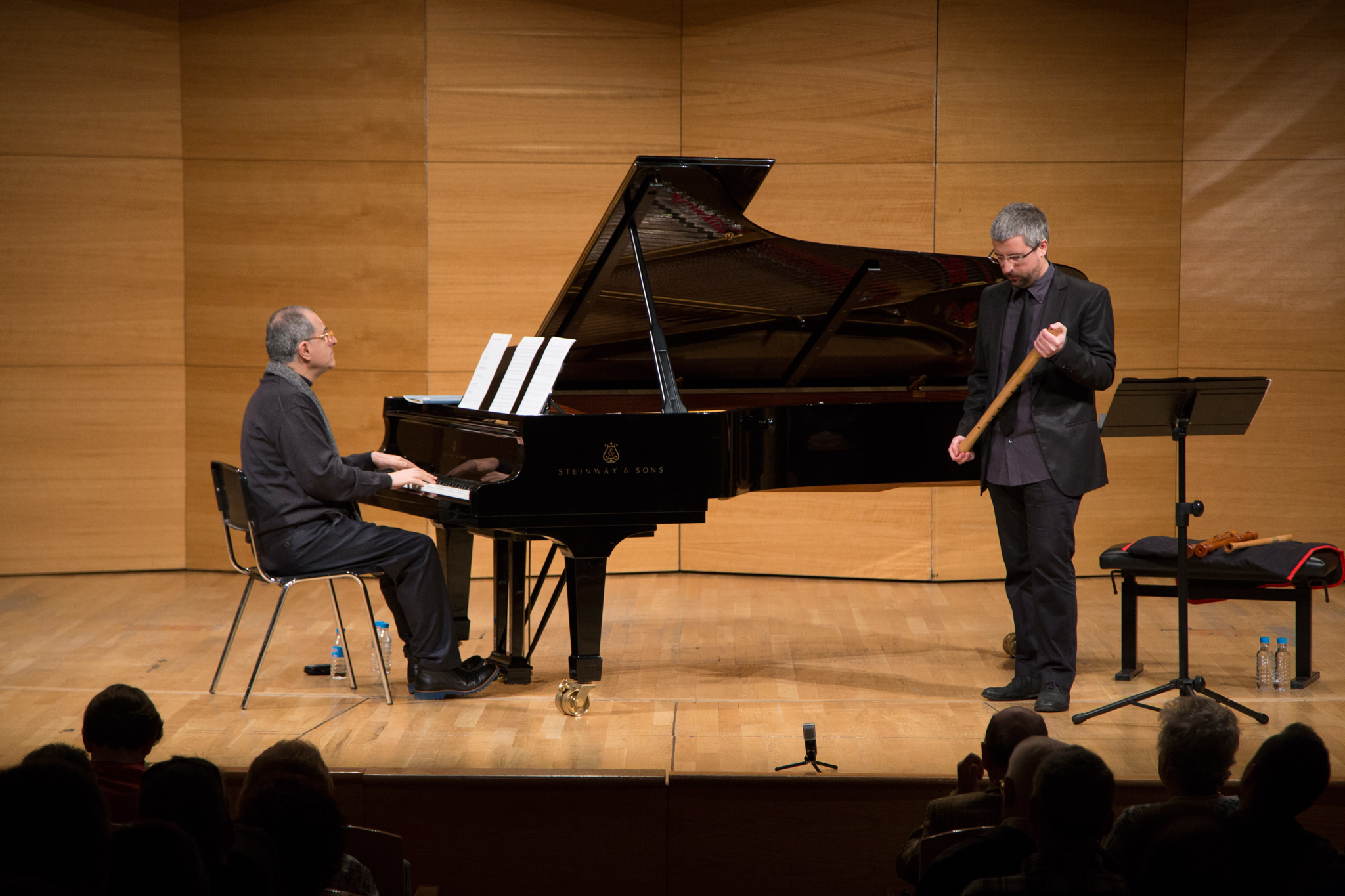
Naturally, the resulting performance was different from what I usually aim at achieving when I play with an early music ensemble. In such a case, we always try to be as faithful as possible to historic styles. Yet on this occasion, two different languages came together. As usual, I was only interested in staying within the scope of the fifteenth-century musical style. But of course, nothing stopped Enrico when he felt like employing modern harmonies during the concert—even if he tried to adapt his harmonic language to the original pieces most of the time.
La Spagna was the earliest piece in the programme. Though Enrico is a deep connoisseur of Baroque composers such as Scarlatti and Bach, it was the first time he had dealt with a fifteenth-century piece. We had no defined structure other than starting and finishing with Guilielmus Monachus’s Falla con misuras counterpoint (from Ms. Perugia 431, ff. 105v–106, originally composed on the La Spagna cantus firmus), which we used as the main theme upon which we improvised in between.10
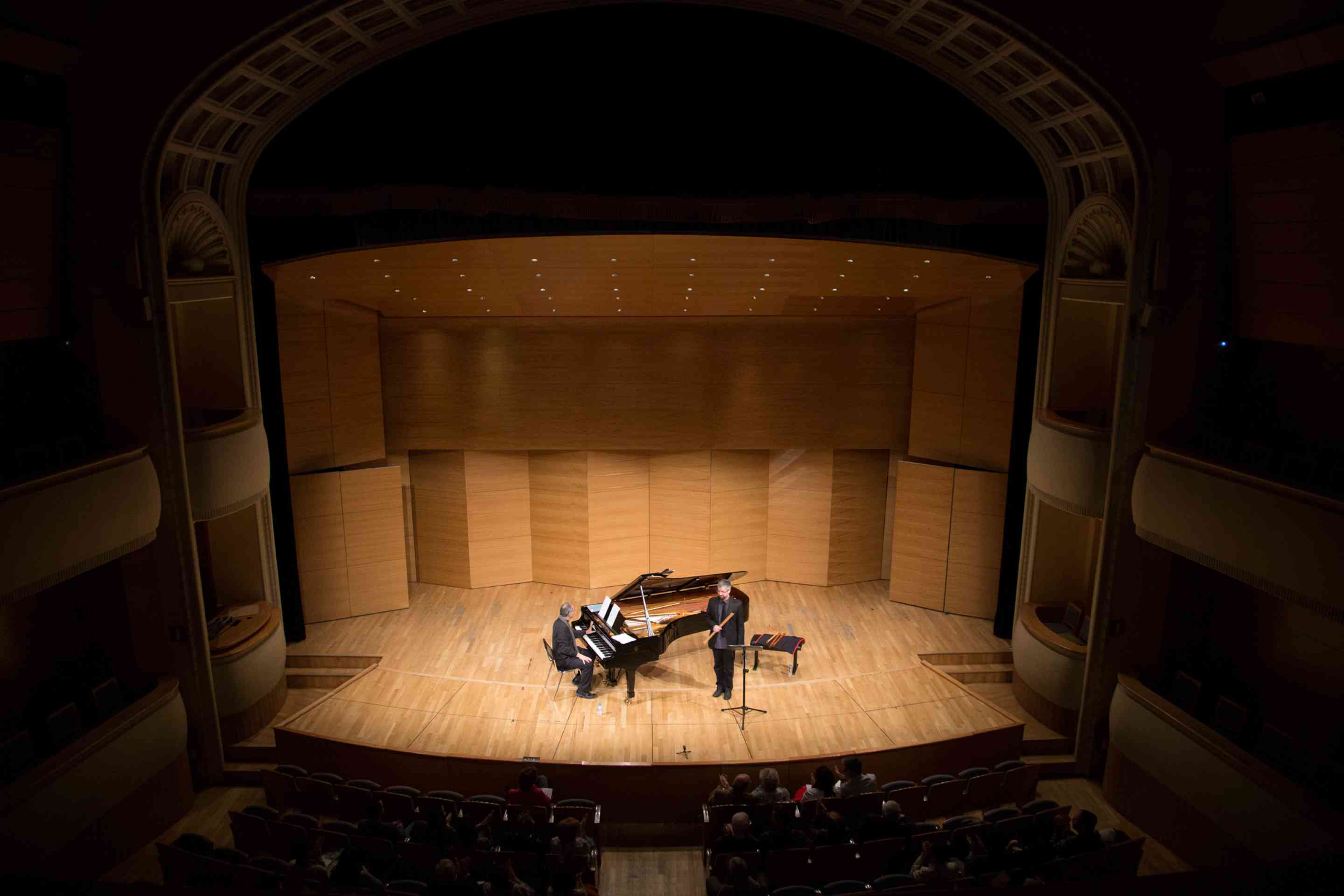
Traces of Guilielmus’s Falla appeared sometimes during our improvisation (bars 1–2 and 31–35 in the transcription, for instance). For the first time, I mostly played rhythmically free counterpoint from the beginning, alternating sections dedicated to a particular rhythmic proportion (such as ×9, ×12, ×15, and ×18; see Table below), with attempts to catch and react to what Enrico was playing (bars 7–18, 33–34, or 61–66, for example).
Apologies for the bad-quality audio: our recording equipment failed at the last moment, so the audio is just the one from the video camera—which was placed at the end of the hall. Headphones recommended for the video.
Video 6: synchronized transcription
Six improvisations on La Spagna [6/6]

Table 6. Version 6: proportions
| Cantus firmus repetition | Bar numbers | Time (video) | Proportions |
|---|---|---|---|
| 1 | 1–6 | 0′ 00″ | Free (Falla’s theme imitation, bars 1–2), ×9 (3–6) |
| 1 | 7–18 | 0′ 11″ | Free, imitative interactions |
| 1 | 19–30 | 0′ 32″ | ×9 (20–22), ×12 (23–28), ×15 (29–30) |
| 1 | 31–39 | 0′ 53″ | Free, Falla’s theme imitation, interactions, ×18 (37–39) |
| 1 to 2 | 40–60 | 1′ 09 ″ | ×12 (40–50), ×18 (51–2), ×12 (53–60) |
| 2 | 61–66 | 1′ 44″ | Interactions |
| 2 | 67–73 | 1′ 54″ | ×12; back to Guilielmus’s theme |
Musicians
Enrico Pieranunzi and Vicente Parrilla duo
Enrico Pieranunzi, piano; Vicente Parrilla, recorder.
7. Overview of the Six Improvisations
This last table will come in handy for a quick comparison of the six transcribed improvisations, and for connecting the reference links to their audio and video files.
Table 7. Overview of the six improvisations
| Version | Source | Recording date | Metronome mark (dotted brevis) | Number of cantus firmus repetitions | Number of bars | Duration of the improvised solo | Audio link | Video link |
|---|---|---|---|---|---|---|---|---|
| 1 | CD recording: Las idas y las vueltas | November 20, 2011 | ±44 | 1 | 45 | 1′ 03″ | Spotify | YouTube |
| 2 | Live concert, Madrid | January 12, 2013 | ±50 | 6 | 275 | 5′ 20″ | x | YouTube |
| 3 | Live concert, Coimbra | April 30, 2014 | ±40 | 7 | 321 | 8′ 00″ | SoundCloud | YouTube |
| 4 | Live concert, Porto | May 3, 2014 | ±40 | 10 | 459 | 11′ 26″ | SoundCloud | YouTube |
| 5 | Live concert, Warsaw | May 16, 2014 | ±38 | 5 | 229 | 6′ 25″ | Bandcamp | YouTube |
| 6 | Live concert, Sevilla | March 15, 2015 | ±34 | 1,5 | 73 | 2′ 05″ | SoundCloud | YouTube |
| 34′ 17″ (Total improvised time) |
Moreover, this table shows how variable in length the different improvisations can be, depending on factors such as:
- Their different functions within a particular performance context—whether they belong to:
1.1. A short, fixed section within a CD recording (version 1)
1.2. A regular piece within a concert programme
1.3. The last encore of the concert (version 5) - The performers involved
Hence the large differences in the duration of the improvised solos, and thus in the number of bars and cantus firmus repetitions.
Afterword
I feel this article contains some of my most important work so far—even if, to my own surprise, its publishing medium is not a CD recording but a URL.11 Perhaps a sign of the times? Don’t get me wrong, I love making CDs, but music does not need a recording session to exist, and our best performances are not always captured on an album. What happens on stage is always the real thing.

At the start of this article, I emphasized the importance of providing visual proof that real improvisation is happening in my performances. These transcriptions, along with the synchronized videos and the data in various tables, make that evident.
While this might be taken for granted in other musical styles—especially jazz—it remains crucial in the world of early music, where improvisation is neither as common nor as developed as it once was. Although there are genuine improvisers in early music today, they are still a minority compared to the many performers who claim to improvise in their concert programmes. That may explain why recordings or videos of truly improvised performances within historical repertoires at a professional level are often difficult to find or remain inaccessible. At the very least, such performances do not circulate with the same normality as in other repertoires where improvisation is an established, living practice.
I hope this article encourages more early music improvisers to share their work publicly.
—VP.
Spread the Word
Thanks for reading. If you are enjoying this, please share it with a friend, or let me know your thoughts.
Also, if you appreciate my work and would like to support and encourage me to keep producing similar articles, you can help by doing one (or more) of the following:
- Pay what you like:
You could also send me a book :)
- Buy a CD
Now that you have some music scores, you might like to have a CD too:
Thanks. Your support makes my continuing work on musical articles possible.
License

“Six transcribed improvisations on La Spagna, 2011–15” by Vicente Parrilla is licensed under a Creative Commons Attribution-ShareAlike 4.0 International License.
Based on a work at https://vicenteparrilla.com/blog/spagna-improvisations.
Permissions beyond the scope of this license may be available at https://vicenteparrilla.com/contact.
☞ You are free to perform the music; to share—copy and redistribute the material in any medium or format; to adapt—remix, transform, and build upon the material for any purpose, even commercially, as long as you follow the license terms.
Many thanks to David Lasocki for editing a draft of this article.
-
This is a slightly adapted version of the original quote, “Once you have been bitten by the jazz bug, it is not a choice anymore,” by Terri Lyne Carrington. ↩
-
Consider the vast bootleg culture that has flourished among jazz enthusiasts: it has been called a “cornucopia for jazz lovers by jazz lovers.” ↩
-
The following is a transcription of Adam Neely’s speech in his video The Cult of the Written Score: “The only surviving record of the music of Western composers of the past four hundred years or so has been in their sheet music. Musical academia has vastly inflated the importance of written music … For whatever reason, musical academia has decided that the written note is more important than the actual performed note. Essentially, musicians are often judged on their ability to play exactly what’s on paper; or composers: it is much more about the process that went into making the music rather than the music itself. I call this the cult of the written score, and it is pervasive in all sorts of academic and collegiate thought.” ↩
-
This is how I did it: I connected a small but powerful Bluetooth speaker to my phone, which played the cantus firmus (previously recorded on a basset recorder) in a continuous loop. After pressing
play, I needed a few seconds to return to the center of the stage. That is why I started playing at bar 8. ↩ -
For example, certain rhythmic patterns (bars 153–154 and 167–168); a spontaneous, rather wild passage (bars 172–176: a (‡) is missing in the transcription); and some extended sections marked by rests (bars 237–240 and 311–321). ↩
-
Accordingly, I moved systematically from ×2 (first round of the cantus firmus) to ×7 (sixth round), followed by a freer section where I played mostly ×10 and ×12 (seventh and eighth rounds), finishing with a progressive slowdown (ninth and tenth rounds). ↩
-
Most clearly in bars 154–156, 222–225, 241–243, 251–256, 345–348, with two particularly long examples in bars 329–336 and 413–417. ↩
-
For instance, the motif in bar 293 (returning in bar 297), or a descending-thirds motif that appears at least three times (bars 201–202, 261–262, and 307). Also, I went a bit wild again in bars 404–406—sorry about that. ↩
-
Since it was the first time I performed this piece with these musicians (and I was used to a steady pulse in the tenor melody), I wanted to ensure that the beat was solid before starting to play. That is why I did not begin until about minute 1. ↩
-
The video above captures only the improvised solo and therefore it does not include Falla con misuras. Here is a video of the complete performance. ↩
-
An open-access URL, easy to share and hopefully future-proof, containing text and audiovisual material. I take the web seriously as a publishing medium. ↩